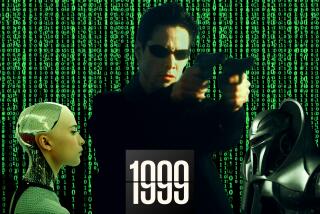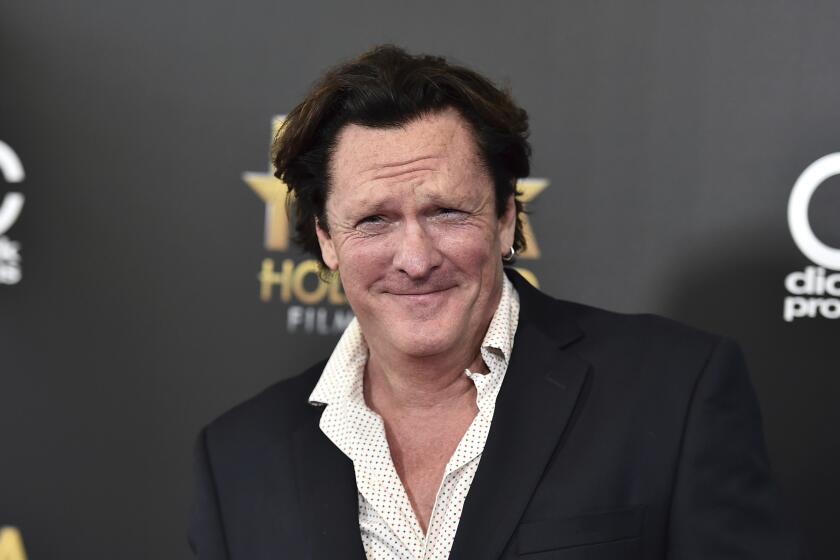Landing with a thud
Once upon a time in 1999, the summer was supposed to belong to George Lucas and “The Phantom Menace,” his resurrected “Star Wars” series. But after “The Matrix” hit, Lucas’ future was yesterday’s news. Suddenly, the action wasn’t in light sabers and an embarrassment like Jar Jar Binks, but in slow-crawling bullets, high-flying warriors, latex and leather, religious allusions, postmodern apercus, recycled future shock and heroes that looked like Keanu Reeves, Laurence Fishburne and Carrie-Anne Moss. That year, the brave new world of the action movie blazed in Reeves’ sunglasses, and it looked cool.
Cool today, gone tomorrow. Now, four years later -- six months after “The Matrix Reloaded” was released into theaters and just three weeks after it hit on DVD -- comes the third and final installment in Andy and Larry Wachowski’s cycle, “The Matrix Revolutions.” Picking up where the second left off, the new film returns to the war raging between machines and the quarter-million human insurgents burrowed near the Earth’s core in a place called Zion.
Masters of the aboveground world, the machines run on energy tapped from human slaves whose bodies are stored in petri dishes while their unsuspecting minds inhabit a world manufactured from code. Dubbed the matrix, this simulacrum looks a lot like our everyday reality, only it’s often tinted dirty-aquarium green and patrolled by software programs that resemble suave Secret Service agents.
Every so often, the insurgents liberate a slave who joins their ranks. Such was the case with Reeves’ Neo -- unscramble his name and he becomes the “One” -- a software coder-turned-warrior messiah. Every hero needs an enemy and Neo’s doppelganger foe is Agent Smith, a software program gone rogue indelibly played by Hugo Weaving. Initially just another machine minion, Smith has emerged as one of the saga’s most vital creations, with Weaving one of its most valuable assets. Unlike the rest of the tamped-down and visibly devitalized leads, the actor continues to play Smith at full tilt. More than any other performer in the trilogy, Weaving -- his dancing eyebrows in contrapuntal harmony with his tom-tom enunciation -- has retained the playfulness, the sheer enjoyment that made the first “Matrix” a blast.
That’s the problem with great villains -- they tend to overwhelm the show, to steal the hero’s thunder and grab the best lines. This time around, when Neo visits the Oracle (Mary Alice, who replaced the late Gloria Foster), if the encounter doesn’t have the kick it once did, it’s partly because we’ve been here, done that, and partly because -- compared to Smith -- these do-gooders are totally square. Once again, the Oracle is doling out cryptic advice in her retro kitchen, baking cookies and dragging on a cigarette, and once again, much of what she says sounds like it came off a Magic 8 Ball (“signs point to yes”). But this time, it’s hard not to shake the feeling that somewhere between the second and third films, after tumbling down the rabbit hole and into Zion, Neo has left the matrix only to land in an episode of “Touched by an Angel.”
How did something that started out so cool get so dorky? An increasingly thin screenplay, for starters, in which every trace of the first film’s Philip K. Dick--inspired paranoia has been replaced with a religious pastiche larded with World War II war-movie cliches. A death scene that in its last-gasp eloquence and longevity verges on the parodic, lousy acting from much of the supporting cast, and, most damaging of all, too many extended-play battle scenes in which the special effects swamp the actors.
As to be expected, the Wachowskis trot out some sensational gewgaws in “The Matrix Revolutions,” including the monstrous killer-drills glimpsed in the last film. But for the first time in the “Matrix” cycle, the machines are more lovingly rendered and attended to than are the human characters.
The irony is unmistakable and perhaps a foregone conclusion. After all, with the first “Matrix,” the Wachowskis created an irresistible liberation story -- about a guy who unplugs from the machine world -- by plugging worldwide audiences into their machine world. Like the Architect (Helmut Bakaitis), the velvet-voiced creator of the matrix inside their movie, the Wachowskis couldn’t let their captives go, especially after fashioning such a beautifully simulated, smooth-functioning and profitable realm. And so, over four years’ time, they have continued to build their world, adding new layers, new bells and whistles. They smartly kept themselves shrouded in mystery as they coordinated two hugely ambitious sequels, released a series of anime shorts and a popular video game, and kept dominion over a dedicated fan base.
But while the fans kept busy teasing out the ostensible deep meaning of “The Matrix” -- their musings complemented by an academic cottage industry that made the film and its admirers seem even smarter -- the brothers had clearly begun to lose sight of what made the first movie a sensation. The transformation of Neo from a man waging a battle on two fronts -- against the machine and his own existential self-doubt -- into an increasingly beatific and bland savior figure has been one of the story’s biggest pulls and among its gravest disappointments. Two years before the first “Matrix” hit, culture critic Thomas Frank nailed what was so appealing about a hero like Neo by observing that there were “few things more beloved of our mass media than the figure of the cultural rebel, the defiant individualist resisting the mandates of the machine civilization.”
That individualist rebel has been a fixture in American movies for decades, riding horses and motorcycles, steering cop cars and even spaceships in the seemingly endless journey toward freedom and self-expression. It was Neo’s struggle and his search for freedom that -- along with the four excellent leads and the seamless fusion of Hong Kong-style action, martial arts, up-to-the minute technology and epistemology (Jean Baudrillard!) -- that turned “The Matrix” into a phenomenon. And what made that struggle and search even better was that it was all so much fun. Neo discovering that he knows kung fu, the smile curling at the corner of Fishburne’s mouth as his character goads Neo to fight, Moss’ come-hither dominatrix -- all were part of the giddy pop pleasure of a movie that was breaking new ground and hadn’t yet congealed with self-importance.
As with many of their filmmaking peers, the Wachowskis have had enormous trouble creating heroes as entertaining as their villains, and they’re clearly turned on more by war than by peace. Agent Smith and the wonderfully sneery Merovingian (Lambert Wilson) are in fine fettle in “The Matrix Revolutions,” and the film’s elaborate fetish ball, populated with assorted pierced miscreants, proves a stark relief from Zion’s artfully snagged sweaters and rectitude.
That love of villainy puts the filmmakers closer to the mainstream than might be otherwise expected from two guys who created a world -- to borrow Neo’s voice-over at the end of “The Matrix” -- “without rules and controls, without borders or boundaries.” But genre moviemaking has its own rules, as does blockbuster success. Which is why, of course, we know exactly how this is going to end.
*
‘The Matrix Revolutions’
MPAA rating: R, for sci-fi violence and brief sexual content
Times guidelines: Violent warfare, adult language
Keanu Reeves...Neo
Laurence Fishburne...Morpheus
Carrie-Anne Moss...Trinity
Hugo Weaving...Agent Smith
Jada Pinkett Smith...Niobe
Warner Bros. Pictures presents in association with Village Roadshow Pictures and NPV Entertainment a Silver Pictures production, released by Warner Bros. Writers-directors Andy and Larry Wachowski. Producer Joel Silver. Director of photography Bill Pope. Production designer Owen Paterson. Editor Zach Staenberg. Music Don Davis. Visual effects supervisor John Gaeta. Costumes Kym Barrett. Running time: 2 hours, 9 minutes.
In general release.
More to Read
Only good movies
Get the Indie Focus newsletter, Mark Olsen's weekly guide to the world of cinema.
You may occasionally receive promotional content from the Los Angeles Times.










